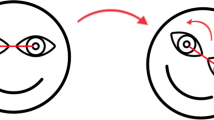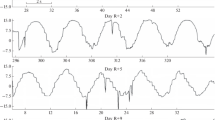Abstract.
During the 1998 Neurolab mission (STS-90), four astronauts were exposed to interaural centripetal accelerations (Gy centrifugation) of 0.5g and 1g during rotation on a centrifuge, both on Earth and during orbital space flight. Subjects were oriented either left-ear out or right-ear out, facing or back to motion. Binocular eye movements were measured in three dimensions using a video technique. On Earth, tangential centrifugation that produces 1g of interaural linear acceleration combines with gravity to tilt the gravitoinertial acceleration (GIA) vector 45° in the roll plane relative to the head vertical, generating a summed vector of 1.4g. Before flight, this elicited mean ocular counterrolling (OCR) of 5.7°. Due to the relative absence of gravity during flight, there was no linear acceleration along the dorsoventral axis of the head. As a result, during in-flight centrifugation, gravitoinertial acceleration was strictly aligned with the centripetal acceleration along the interaural axis. There was a small but significant decrease (mean 10%) in the magnitude of OCR in space (5.1°). The magnitude of OCR during postflight 1g centrifugation was not significantly different from preflight OCR (5.9°). Findings were similar for 0.5g centrifugation, but the OCR magnitude was approximately 60% of that induced by centrifugation at 1g. OCR during pre- and postflight static tilt was not significantly different and was always less than OCR elicited by centrifugation on Earth for an equivalent interaural linear acceleration. In contrast, there was no difference between the OCR generated by in-flight centrifugation and by static tilt on Earth at equivalent interaural linear accelerations. These data support the following conclusions: (1) OCR is generated predominantly in response to interaural linear acceleration; (2) the increased OCR during centrifugation on Earth is a response to the head dorsoventral 1g linear acceleration component, which was absent in microgravity. The dorsoventral linear acceleration could have activated either the otoliths or body-tilt receptors that responded to the larger GIA magnitude (1.4g), to generate the increased OCR during centrifugation on Earth. A striking finding was that magnitude of OCR was maintained throughout and after flight. This is in contrast to most previous postflight OCR studies, which have generally registered decreases in OCR. We postulate that intermittent exposure to artificial gravity, in the form of the centripetal acceleration experienced during centrifugation, acted as a countermeasure to deconditioning of this otolith-ocular orienting reflex during the 16-day mission.
Similar content being viewed by others
Author information
Authors and Affiliations
Additional information
Electronic Publication
Rights and permissions
About this article
Cite this article
Moore, S., Clément, G., Raphan, T. et al. Ocular counterrolling induced by centrifugation during orbital space flight. Exp Brain Res 137, 323–335 (2001). https://doi.org/10.1007/s002210000669
Received:
Accepted:
Issue Date:
DOI: https://doi.org/10.1007/s002210000669




